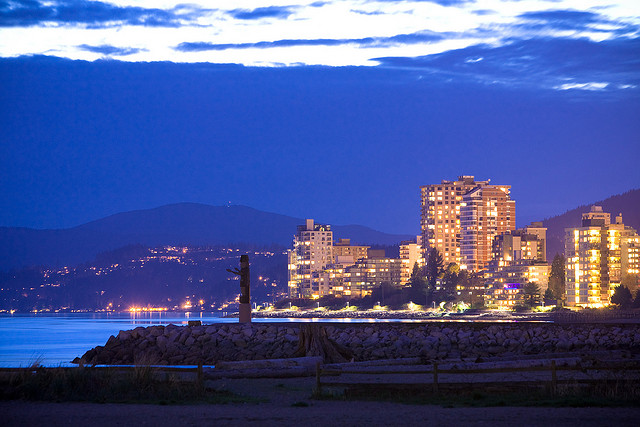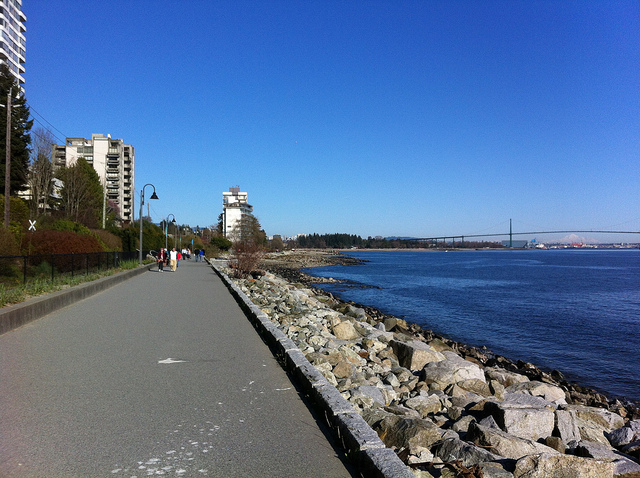WEST VANCOUVER
 |
West Vancouver, long-known for breathtaking views across the city of Vancouver and as far south as Mount Baker, WA, has undergone interesting changes over the past 20 years. Originally a summer cottage community around the 1880s, West Vancouver was slow to incorporate. North Vancouver incorporated in 1891, but it wasn’t until 1912 that West Vancouver followed suit. Until then, West Van, as it is commonly referred to, was a playground a world apart from the bustling downtown Vancouver area. Accessed primarily by The West Vancouver Transportation Company ferry or private marine vessels, the community was then a mere 1500 residents ... until Alfred Taylor and the First Narrows, or Lions Gate Bridge, came along. |
West Vancouver is the birthplace of contemporary ‘West Coast Style’ architecture, architecture that made the most of rocky building sites, impressively tall forests, and incredible views of Vancouver, White Rock, Mount Baker, Georgia Strait (now called The Salish Sea) and Vancouver Island. Geometrics, open-plan layouts, natural light, glass, post & beam construction, skylights and glazing, wood finishes, native landscaping and a unique integration between indoors and outdoors revolutionized architecture on the West Coast of North America, casting Canadian architects like Arthur Erickson, Ned Pratt, and Ron Thom into the international spotlight. This building style is at the heart of thousands of West Vancouver residences today.
RECREATION
West Vancouver is a recreational delight. Cypress Mountain (formerly known as Cypress Bowl), once only a cross country skiing destination, has matured into a wonderful mix of cross-country, downhill chairlift runs, tubing runs and snowshoe trails in the winter, and in summer attracts hikers and mountain bikers, geocachers .... and to road cyclists looking for bad-ass training in the Vancouver area. With a climb of almost 2400 ft and timing signs helpfully posted, this gorgeous ascent offers an incredible ride down with some of the most beautiful views of the city. Hollyburn Mountain was known in the 1920s as a ski racing and ski jumping destination with races sanctioned by the Canadian Amateur Ski Association. Races wound up and down through the West Van mountains and required skills in both cross country and downhill telemarking for a unique thrill. Ski jumping began on the edge of First Lake in 1930, and in 1936 the West Lake Ski Jump opened; unfortunately and to the great dismay of enthusiasts the property was sold to the District of West Vancouver in 1938 and closed.
The Hollyburn Heritage Society was formed in 1988 to restore the Hollyburn Ski Lodge and share the history of Hollyburn, Black and Strachan mountains. The Hollyburn Ski Lodge project continues to this day, with elementary history program, the Hollyburn Book Project and video series. Hollyburn Ridge has been home to a unique cabin community since the 1920s; approximately 100 cabins are still in use and accessed only by forholybuest trails, making building or renovating a labor-intensive process. Primarily built or renovated by young adults, these cabins are a testament to rugged individualism (read: trial and error construction!). While cabin communities on North Shore mountains have disappeared, the Hollyburn community is alive and well today, with a waiting list of folks glued to the “Hollyburn Ridgerunner” newsletter hoping to hear of a cabin becoming available.
 |
West Vancouver is also known for its beautiful waterfront, including popular level walking trails ideal for people of all fitness levels, a number of wooded parks, and the gorgeous Lighthouse Park at the western edge of West Van with its huge old-growth Douglas firs and rainforest climate (over 1300mm of rain falls annually in the park). There are steep cliffs and commanding views. Whytecliff Park, southwest of Horseshoe Bay, is noted as an excellent scuba diving destination with regular underwater sightings of bottom fish, anemones, seals and occasionally wolf eels and giant Pacific octopus. Pleasure boating and sailing are also very popular in West Vancouver, with a number of marinas and a busy sailing club. |
SHOPPING AND DINING
From the large-footprint Park Royal Shopping Centre to quaint Dundarave Village to Caulfeild Village’s uniquely presented shops, West Vancouver has much to offer. Often described as “one of the most expensive zip codes in Canada”, West Van is the place to see and be seen. Shoppers will find all of the ‘Robsonstrasse’ stores well-represented across the pond, with several unique additions sprinkled throughout each main retail area. In the summer, a vibrant farmer’s market operates weekly in Ambleside, every Sunday from the 1st Sunday in May to the last Sunday in October with organic produce, specialty food products, arts & crafts, flowers and plants, and gifts full of personality.
Dining in West Van ranges from Italian, French, British, Japanese, Indian to West Coast eclectic and extraordinarily fine dining meals. Pubs, cafes, seafood bars, and the de rigueur fast food outlets means everyone in the family can find something they like. Standout restaurants include Chez Michel, Fraiche, Rockford Wok Bar & Grill, The Boathouse Restaurant, and The Salmon House.
Dining in North Van offers a range of experiences from fine dining at The Salmon House and The Observatory atop Grouse Mountain to Browns Socialhouse, the Rockford Wok Bar Grill, and Palki Indian Restaurant.
SERVICES & SCHOOLS
Lions Gate Hospital is a 268-bed facility with seven operating rooms, a wide range of diagnostic services and is the fourth busiest hospital in Vancouver, and one of only five neurosurgery centres in the province. It’s also the go-to hospital for patients from the Sunshine Coast and Powell River who need urgent care via helicopter or scheduled surgeries not offered in their smaller regional hospitals.
The West Vancouver School District 45 consists of 14 Primary/Elementary Schools and 3 Secondary Schools. This includes two French immersion schools, a Montessori school, and an elementary school with a special focus on the cultural heritage of the Squamish First Peoples. District 45 includes the populations of Bowen Island, Horseshoe Bay and Lions Bay.




